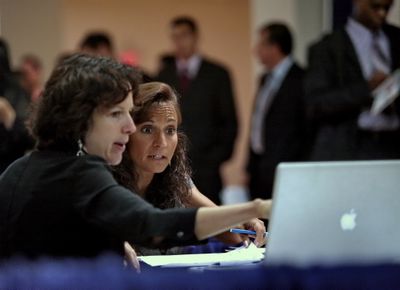High jobless claims show economy’s weak

WASHINGTON – Even though new claims for jobless benefits fell more than expected last week, dipping below 600,000 for the first time since early January, the number of Americans seeking this safety net points to an economy that is still very weak.
Layoffs are slowing, but jobs are scarce, leaving nearly 7 million Americans collecting unemployment checks and retailers looking for customers.
The number of newly laid-off workers requesting unemployment insurance fell by 52,000 to a seasonally adjusted 565,000, the Labor Department said Thursday. But the drop was mostly due to a shift in the timing of auto-related layoffs, leading many economists to discount the decline.
Weekly claims remain far above the 300,000 to 350,000 range that analysts say is consistent with a healthy economy. New claims last fell below 300,000 in early 2007. The lowest level this year was 488,000 for the week ended Jan. 3.
Thursday’s figure indicates that “very steep job losses” likely will continue and that the unemployment rate will keep rising, said Zach Pandl, an economist at Nomura Securities International.
Claims may not drop to 350,000 until the middle of next year, he said.
Employers cut 467,000 jobs in June, more than analysts expected, while the unemployment rate rose to 9.5 percent, the highest in 25 years. The lack of jobs is limiting consumer spending, which will weaken or even delay any economic recovery.
Retailers reported yet another sluggish month of sales in June, increasing concerns about the critical back-to-school season. Among the most worrisome signs were the sharp sales declines from mall-based shops that cater to teens like Abercrombie & Fitch and American Eagle Outfitters, indicating that parents will keep scouring for bargains at discount chains.
The International Council of Shopping Centers-Goldman Sachs same-store sales tally for June fell 5.1 percent from a year ago, steeper than the 4.5 percent decline analysts expected. Same-store sales – sales at stores open at least a year – are considered a key indicator of a retailer’s health.
The results marked the 11th consecutive month of same-store sales decreases, and some analysts expect that trend to continue through the rest of the year as consumer spending is constrained by tight credit and a weak job market.
Meanwhile, the number of people on the jobless benefit rolls jumped 159,000 to 6.88 million, the Labor Department said. That’s the highest tally on records dating from 1967. Continuing claims had fallen in two of the previous three weeks. The data lag initial claims by a week.
Economists said the increase showed employers remain hesitant to add new workers, despite some recent signs the economy is stabilizing.
“The problem is, no one is hiring,” said Mark Vitner, senior economist at Wells Fargo Securities.
That will likely keep driving up the unemployment rate even as layoffs slow, he said. Wells Fargo projects the rate will peak at 10.5 percent next year.